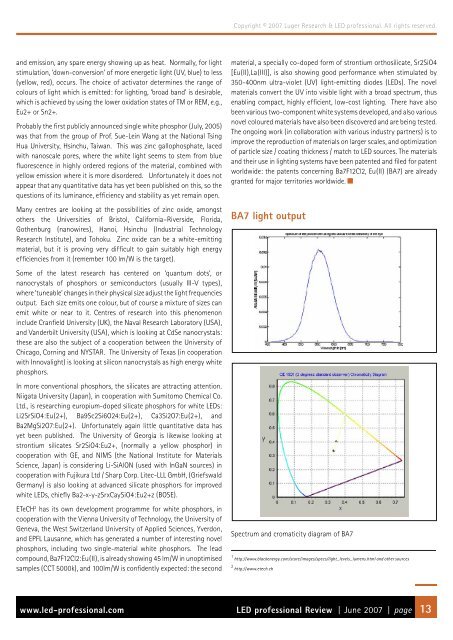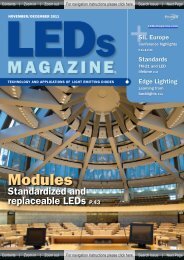LED drivers Phosphor technology - Beriled
LED drivers Phosphor technology - Beriled
LED drivers Phosphor technology - Beriled
You also want an ePaper? Increase the reach of your titles
YUMPU automatically turns print PDFs into web optimized ePapers that Google loves.
and emission, any spare energy showing up as heat. Normally, for light<br />
stimulation, ‘down-conversion’ of more energetic light (UV, blue) to less<br />
(yellow, red), occurs. The choice of activator determines the range of<br />
colours of light which is emitted: for lighting, ‘broad band’ is desirable,<br />
which is achieved by using the lower oxidation states of TM or REM, e.g.,<br />
Eu2+ or Sn2+.<br />
Probably the first publicly announced single white phosphor (July, 2005)<br />
was that from the group of Prof. Sue-Lein Wang at the National Tsing<br />
Hua University, Hsinchu, Taiwan. This was zinc gallophosphate, laced<br />
with nanoscale pores, where the white light seems to stem from blue<br />
fluorescence in highly ordered regions of the material, combined with<br />
yellow emission where it is more disordered. Unfortunately it does not<br />
appear that any quantitative data has yet been published on this, so the<br />
questions of its luminance, efficiency and stability as yet remain open.<br />
Many centres are looking at the possibilities of zinc oxide, amongst<br />
others the Universities of Bristol, California–Riverside, Florida,<br />
Gothenburg (nanowires), Hanoi, Hsinchu (Industrial Technology<br />
Research Institute), and Tohoku. Zinc oxide can be a white-emitting<br />
material, but it is proving very difficult to gain suitably high energy<br />
efficiencies from it (remember 100 lm/W is the target).<br />
Some of the latest research has centered on ‘quantum dots’, or<br />
nanocrystals of phosphors or semiconductors (usually III-V types),<br />
where ‘tuneable’ changes in their physical size adjust the light frequencies<br />
output. Each size emits one colour, but of course a mixture of sizes can<br />
emit white or near to it. Centres of research into this phenomenon<br />
include Cranfield University (UK), the Naval Research Laboratory (USA),<br />
and Vanderbilt University (USA), which is looking at CdSe nanocrystals:<br />
these are also the subject of a cooperation between the University of<br />
Chicago, Corning and NYSTAR. The University of Texas (in cooperation<br />
with Innovalight) is looking at silicon nanocrystals as high energy white<br />
phosphors.<br />
In more conventional phosphors, the silicates are attracting attention.<br />
Niigata University (Japan), in cooperation with Sumitomo Chemical Co.<br />
Ltd., is researching europium-doped silicate phosphors for white <strong>LED</strong>s:<br />
Li2SrSiO4:Eu(2+), Ba9Sc2Si6O24:Eu(2+), Ca3Si2O7:Eu(2+), and<br />
Ba2MgSi2O7:Eu(2+). Unfortunately again little quantitative data has<br />
yet been published. The University of Georgia is likewise looking at<br />
strontium silicates Sr2SiO4:Eu2+, (normally a yellow phosphor) in<br />
cooperation with GE, and NIMS (the National Institute for Materials<br />
Science, Japan) is considering Li-SiAlON (used with InGaN sources) in<br />
cooperation with Fujikura Ltd / Sharp Corp. Litec-LLL GmbH, (Griefswald<br />
Germany) is also looking at advanced silicate phosphors for improved<br />
white <strong>LED</strong>s, chiefly Ba2-x-y-zSrxCaySiO4:Eu2+z (BOSE).<br />
ETeCH 2 has its own development programme for white phosphors, in<br />
cooperation with the Vienna University of Technology, the University of<br />
Geneva, the West Switzerland University of Applied Sciences, Yverdon,<br />
and EPFL Lausanne, which has generated a number of interesting novel<br />
phosphors, including two single-material white phosphors. The lead<br />
compound, Ba7F12Cl2:Eu(II), is already showing 45 lm/W in unoptimised<br />
samples (CCT 5000k), and 100lm/W is confidently expected: the second<br />
Copyright © 2007 Luger Research & <strong>LED</strong> professional. All rights reserved.<br />
material, a specially co-doped form of strontium orthosilicate, Sr2SiO4<br />
[Eu(II),La(III)], is also showing good performance when stimulated by<br />
350-400nm ultra-violet (UV) light-emitting diodes (<strong>LED</strong>s). The novel<br />
materials convert the UV into visible light with a broad spectrum, thus<br />
enabling compact, highly efficient, low-cost lighting. There have also<br />
been various two-component white systems developed, and also various<br />
novel coloured materials have also been discovered and are being tested.<br />
The ongoing work (in collaboration with various industry partners) is to<br />
improve the reproduction of materials on larger scales, and optimization<br />
of particle size / coating thickness / match to <strong>LED</strong> sources. The materials<br />
and their use in lighting systems have been patented and filed for patent<br />
worldwide: the patents concerning Ba7F12Cl2, Eu(II) (BA7) are already<br />
granted for major territories worldwide.<br />
BA7 light output<br />
Spectrum and cromaticity diagram of BA7<br />
1 http://www.blackenergy.com/store/images/specs/light_levels_lumens.html and other sources<br />
2 http://www.etech.ch<br />
www.led-professional.com <strong>LED</strong> professional Review | June 2007 | page 13

















